Non-Orthogonal Multi-Carrier Transmission for Internet via Satellite
Yang Yang, Lidong Zhu
National Key Laboratory of Science and Technology on Communications, University of Electronic Science and Technology of China,Chengdu 611731, China
I. INTRODUCTION
Over the last decade, Internet has emerged as not only a tool for personal and corporate communications but also an important infrastructure to meet the basic needs of people to obtain and process information. Now, with the development of mobile communication technology, the world has entered the era of mobile internet. Through the mobile communication system, more and more people and devices can access the Internet anywhere and anytime. As more people connect to the Internet, increasingly chat to friends and family, watch videos on the move, and listen to streamed music on their mobile devices,mobile data traffic continues to grow at unprecedented rates. The combination of mobile communication technology and Internet has produced enormous profits in both economy and society. The government in many countries has also realized the potential of Internet and mobile communication to transform the lives of people in all cross sections of society.Digital inclusion and broadband access to Internet are now being included in the national policies of many countries [1].
Although most of the countries have benefited in the digital pro fits, nearly one half of the people in the world could not access the Internet as the areas where they live are not covered by terrestrial communication infrastructures, and moreover, some areas such as oceans (2/3 of the Earth surface) and the sky cannot physically be served by traditional terrestrial mobile communication systems. In order to increase the coverage area and enhance the coverage effect, Internet via satellite is emerging as the important solution for providing broadband access to the remote areas and also to supplement the terrestrial mobile communication network as backup. Furthermore, Internet via satellite can guarantee long range communication, ensure emergency management for disaster and reduce the difficulty of global network deployment. The range of application of Internet via satellite include but not limit to professional Internet communication applications, passenger Internet communications on the move related applications (roadcar, bus, rail, sea-ships, aircraft ), Internet of things [1].
Satellite mobile communication systems and terrestrial mobile cellular systems are complementary in many ways such as coverage and data rates [2]. Therefore, integrating satellites with the terrestrial system is perhaps the key area that enables many advantages.Satellites may be considered as additional components in future networks by allowing direct handover to terrestrial ratio interfaces as shown in Fig. 1 [3].
Nevertheless, it’s very difficult to integrate space and ground communication systems at present stage because of different air interface technology and network protocols. Until now,terrestrial mobile communication systems have evolved through a series of generations from Analogue (1G) through GSM (2G) via IMT 2000 (3G) to today’s LTE (4G) systems[4]. Satellite mobile systems have developed independently of the terrestrial systems for a long time. There has been a fairly loose connection in their technology deployment roadmap. Seeing from typical air interface technology recently, today’s LTE systems adopted orthogonal frequency division multiplex(OFDM) which is classified as Multi-Carrier(MC) technique. On the contrary, most of satellite communication systems choose the single-carrier technique. Two kinds of air interface technologies have a gap of generation so that they are incompatible with each other.
In comparison to single-carrier technology,Multi-Carrier techniques have a lot of advantages for terrestrial communication such as high spectrum efficiency, small inter-symbol interference (ISI) and simple equalization while maintaining a high rate of transmission especially under the channel condition of multipath interference. Moreover, as the current choice of 4G multi-carrier transmission,modulation and demodulation of OFDM can be implemented by simple inverse fast Fourier transform (IFFT) and fast Fourier transform(FFT) without complex hardware structure.Facts proved that LTE systems have achieved the designed goal in high throughput [5].
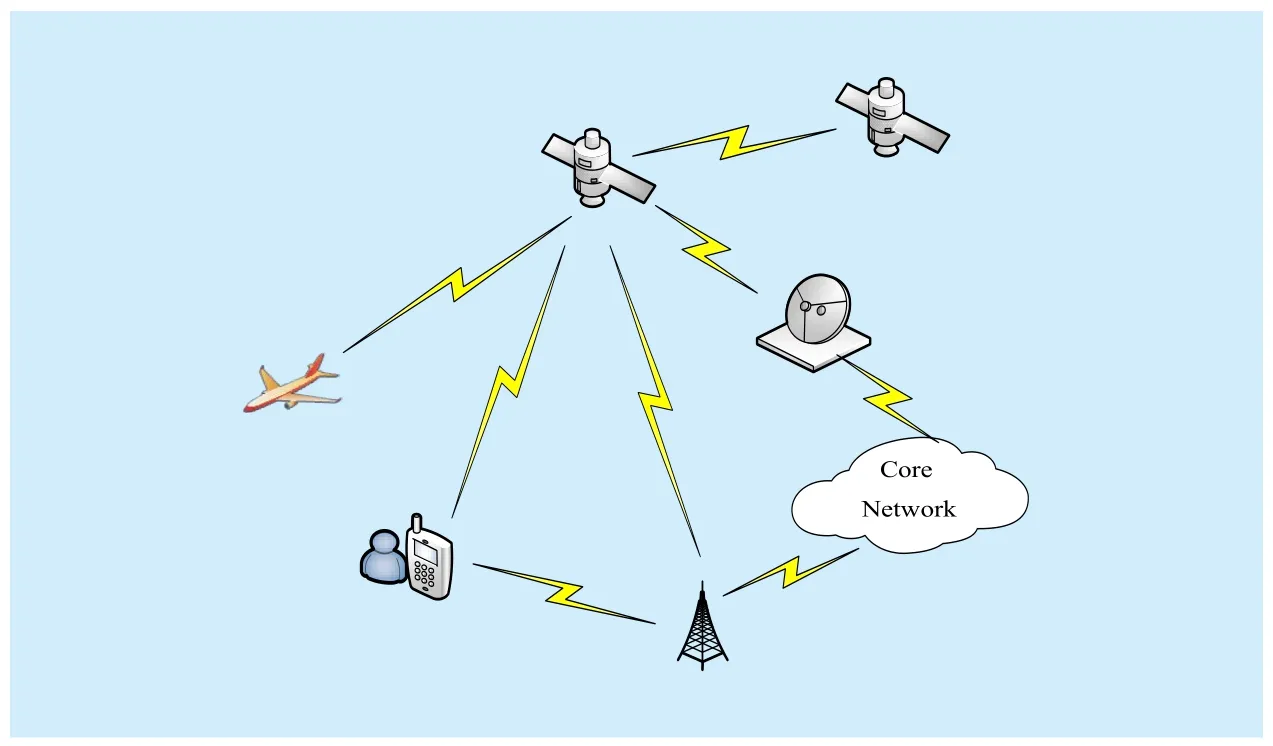
Fig. 1 Internet via space-terrestrial integrated mobile communication system in future
Compared to advantages, several disadvantages seriously affect the use of OFDM in satellite communication systems. First of all, the peak-to-average power ratio (PAPR) of OFDM signal is higher than singles-carrier signal,which leads to low efficiency of High Power Amplifiers (HPAs) in satellite and sensitive to non-linear channel distortion. Secondly, the out-of-band radiation of OFDM signal is high so that the wider guard interval in spectrum is needed, which faces the challenge for the dynamic spectrum access. Thirdly, OFDM based systems are sensitive to error of synchronization but the strict synchronization in satellite channel can’t be achieved easily [6]. All these drawbacks not only make OFDM not the appropriate transmission waveform via satellite but also not the most promising candidate technology for the next generation (5G) of terrestrial mobile communications.
In order to overcome the disadvantages mentioned above, some Non-Orthogonal MC transmission schemes are proposed to replace OFDM as promising transmission technique for the 5th generation of mobile communication systems [7]. Comprehensive evaluation of these technologies is helpful to provide a reference for satellite air-interface design.
Filter Bank Multicarrier (FBMC) [8] is one of the promising technology which is most investigated filtered multicarrier systems. In FBMC, the subcarriers are pulse shaped individually to reduce the out-of-band radiation.The modulation and demodulation of FBMC is implemented by analysis and synthesis filter banks with good time-frequency location property [9]. Because the subcarriers have narrow bandwidth, the length of the transmit filter impulse response is usually long. It means that the solution of FBMC is not suitable in low-latency scenarios. Moreover, FBMC is difficult to be compatible with Multiple Input Multiple Output (MIMO) technology, which is the most important key technology for the next generation cellular mobile communication systems.Universal Filtered Multicarrier (UFMC) [10]is another proposal where a group of subcarriers are filtered, which the number and the length of filter are configured according to demands. Compared to FBMC, the bandwidth of the filter is wider and the length of impulse response can be short. Hence, the UFMC has advantage in short burst transmission. UFMC does not require a cyclic prefix (CP) so it’s more sensitive to small symbol timing offset.It might not be suitable for applications that require loose time synchronization for example satellite communication.
Generalized Frequency Division Multiplexing (GFDM) [11], a flexible MC transmission scheme, is proposed as the promising air interface of 5G network.
Compared to the other MC transmission scheme, the most advantages of GFDM is flexibility and adaptability, which is easily compatible for CP-OFDM and single carrier frequency domain equalization (SC-FDE).Smooth evolution from LTE systems to 5G is the important factor related to the success of mobile systems upgrading. GFDM divides time and frequency resource into independent blocks, where each block contains a number of subcarriers and subsymbols. The prototype filter that circularly shift in time and frequency domain can control the mask of spectrum and reduce out-of-band radiation. The number of subcarriers and sub-symbols can be flexible and configurable according to different situation. For example, when low latency and low PAPR is demanded in the satellite communication, GFDM can address these requirements by reducing the number of subcarriers and redesign the time and frequency structure.In addition, GFDM supports lower overhead than OFDM because it adds CP for the whole blocks which contain multiple subsymbols.Additional CP is helpful when GFDM is effectively combined with MIMO. Moreover,the modulation and demodulation of GFDM signal can be realized by IFFT and FFT like OFDM. So it can be implemented in hardware easily.

Fig. 2 Block diagram of the transceiver
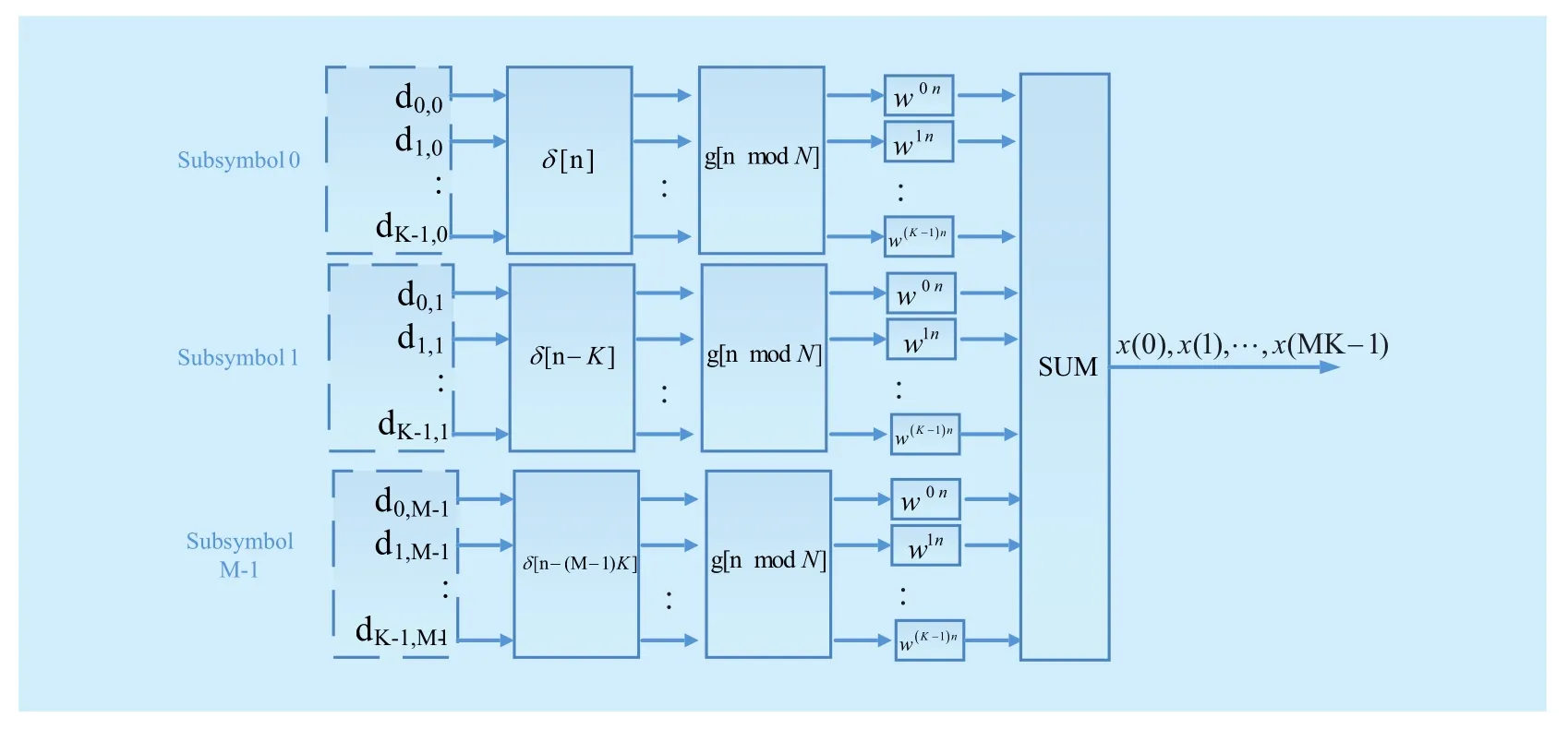
Fig. 3 Block diagram of GFDM modulator
Although many advantages of OFDM are inherited by GFDM, the non-orthogonal property makes both inter-symbol interference(ISI) and inter-carrier interference (ICI) rise.In this case, some interference cancellation algorithms must be used in the receiver to guarantee the symbol error rate (SER), which increases the complexity. A low complexity demodulation algorithm is worth studying[12].
Through the comprehensive evaluation and comparisons above, it is worth discussing the application of GFDM in future Internet via satellite systems as potential air-interface technology, especially the implementation of GFDM and the novel receiving algorithm with low complexity.
The rest of the paper is organised as follows. In Section II, the overview of GFDM is given. Section III presents implementation of GFDM transceiver, In section IV, improved GFDM receiver is discussed, highlighting the new low complexity demodulation algorithm based on pilot subsymbol. The simulation and analysis are discussed to verify the algorithm correctness in Section V. A conclusion is drawn in Section VI.
II. THE OVERVIEW OF GFDM
Considering a typical GFDM transceiver scheme [13] as depicted in Fig. 2, firstly, binary data is coded, then mapped to complex constellation symbols. The mapping rule depends on the type and modulation order of mapper,e.g. 8PSK or 4QAM. Letdenotes the symbols vector which contains N elements. The total number N should be the product of K and M, where K is number of subcarriers and M is number of subsymbols. The datais divided into K blocks where each subcarrier block includes Msubsymbols. In other words,can be represented by means of block matrix

The propagation through a wireless channel can be modelled as



Fig. 4 Block diagram of GFDM modulation in time domain
III. THE IMPLEMENTATION OF GFDM TRANSCEIVER
In this section, the modulation and demodulation model of GFDM is described.
The modulation of GFDM can be conclude aswhere T is a N by N transmission matrix whose column vector isThrough the derivation from formula (4), the modulation operations in time domain is given by

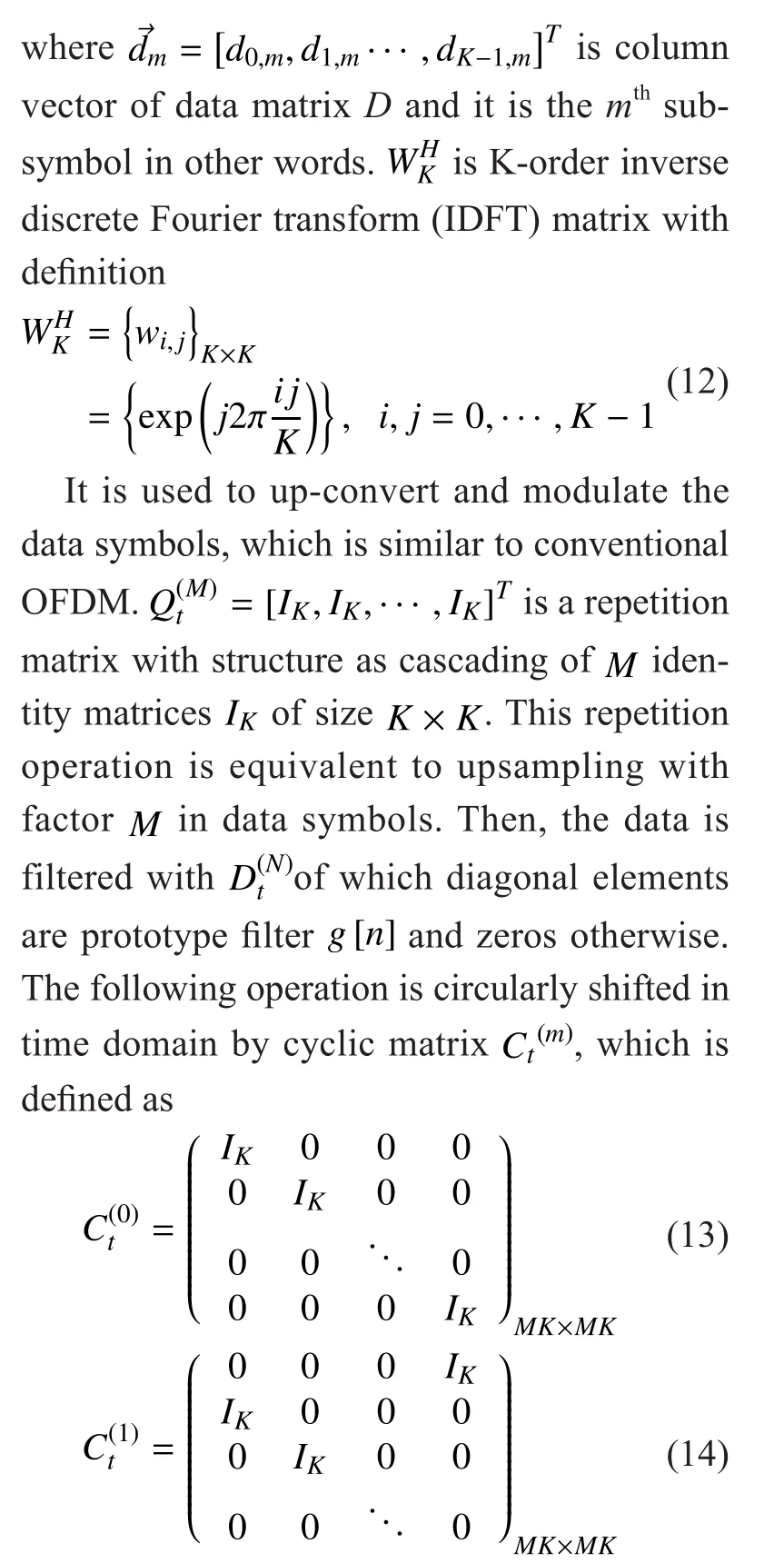
etc. At last, the summation of Msubsymbols is the transmission signal. These operations are illustrated in Fig. 4.
Because of duality between time and frequency, GFDM modulation operations can be also implemented in the frequency domain[17]. The transmission operations can be expressed in the form of matrix as

Fig. 5 Block diagram of GFDM modulation in frequency domain

L is an important parameter that decides the fold coefficient of subcarriers in frequency domain. It is also the upsampling factor in time domain.
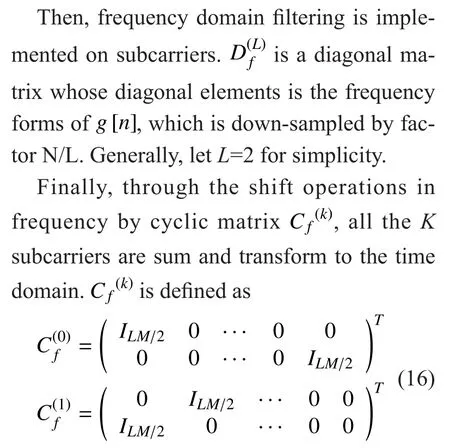
etc. All the processes of modulation in frequency are shown in Fig. 5.
Considering computational complexity of the modulation in time domain and in frequency domain respectively, they can be set asand. Under the assumption computational complexity is equivalent to complex valued multiplication times and summation times is ignored,andcan be expressed as
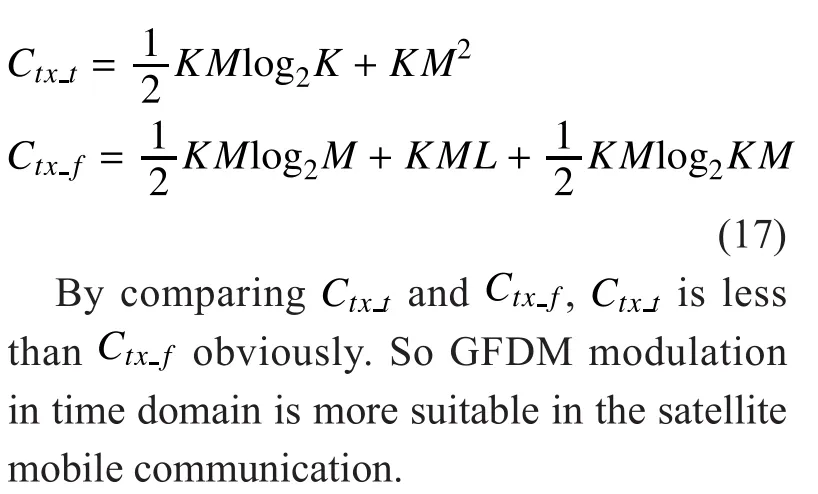
With the corresponding to modulation,GFDM demodulation can be implemented in the time domain or in the frequency domain.For the deriving simplicity, it is necessary to assume that perfect synchronization is operated and the channel is perfect without noise.Demodulation algorithm is MF because it has low complexity and good compatible property in satellite communication. The MF operation in time domain can be expressed as
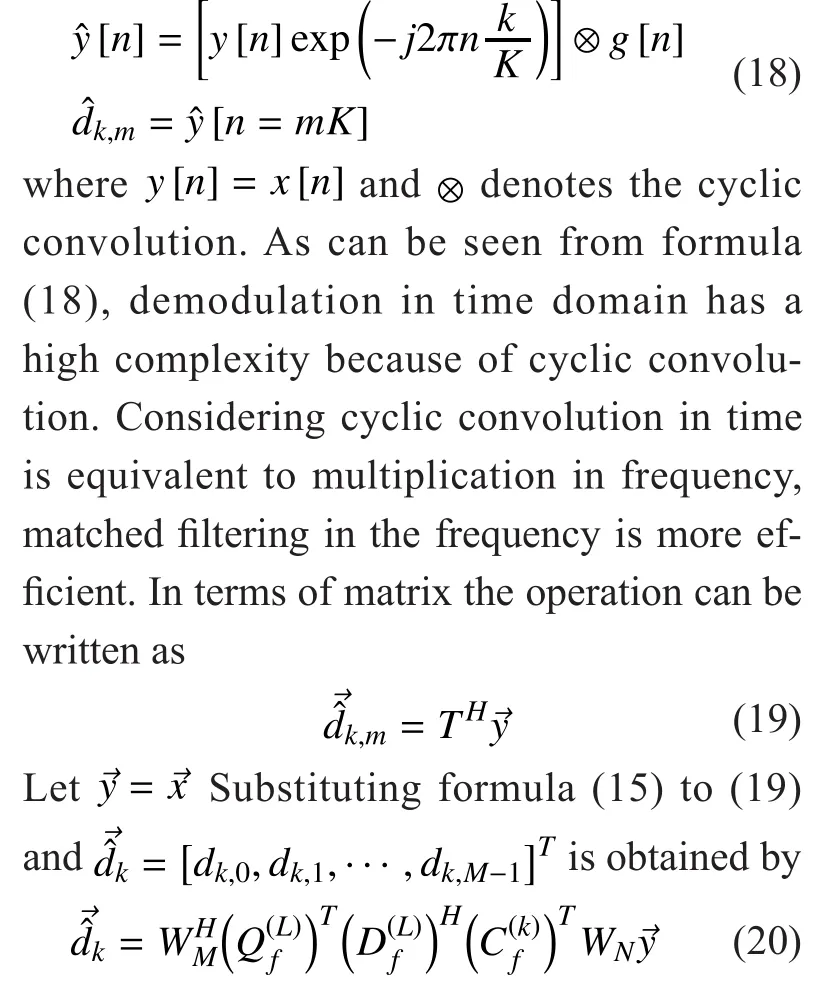
Herein, through the N-points FFT by multiplication with DFT matrix, received signal is transformed to frequency domain.
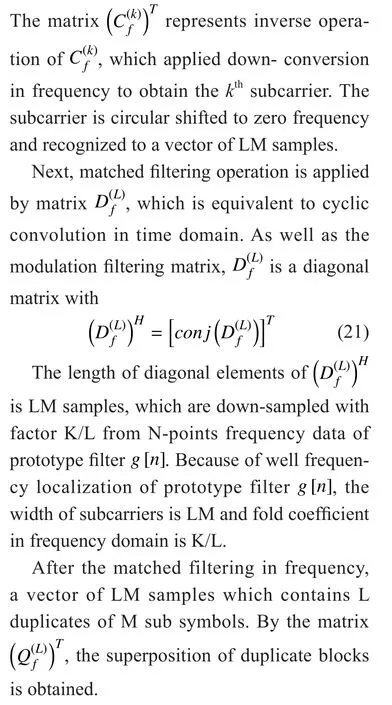
At last, by making the M-points IFFT and demapping from constellation, the M binary subsymbols in kthsubcarrier are recovered.
IV. IMPROVED GFDM RECEIVER
In GFDM transceiver, the frequency coefficientsof prototype filterdecide the shape of per subcarriers where. Some filters such as raised cosine filter (RC),root raised cosine filter (RRC), Xia 1stand Xia 4th[18]with well low pass property can be chosen as prototype filter. The steepness of transition is controlled by roll-off factorfrom 0 to 1. When α=0, the shape of filter in frequency is rectangular pulse, while α=1 the width of pulse is twice than rectangular. The shape of pulse in frequency can be designed to reduce the ICI and out-band emission of GFDM [19].
However ICI between adjacent subcarriers can not be reduced by designing the shape of filter because the width of subcarriers is L times wider than space of subcarriers. Let L=2 for convenience thus the width of subcarriers is 2M. Due to the space of subcarriers is M,there are M samples in frequency overlap between the adjacent subcarriers.
In the situation of satellite communication, the complexity of receiver is limited by platform. When the receiver filter is matched filtered in the frequency domain, the detection SNR is maximum but it is not able to reduce the self-interference between adjacent subcarriers, which affects the performance of symbols error rate (SER). Hence some interference cancellation algorithm should be adopted in MF receiver to improve the receiver performance [20][21].
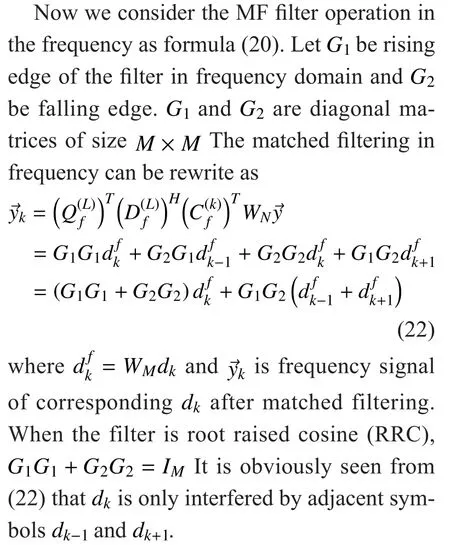
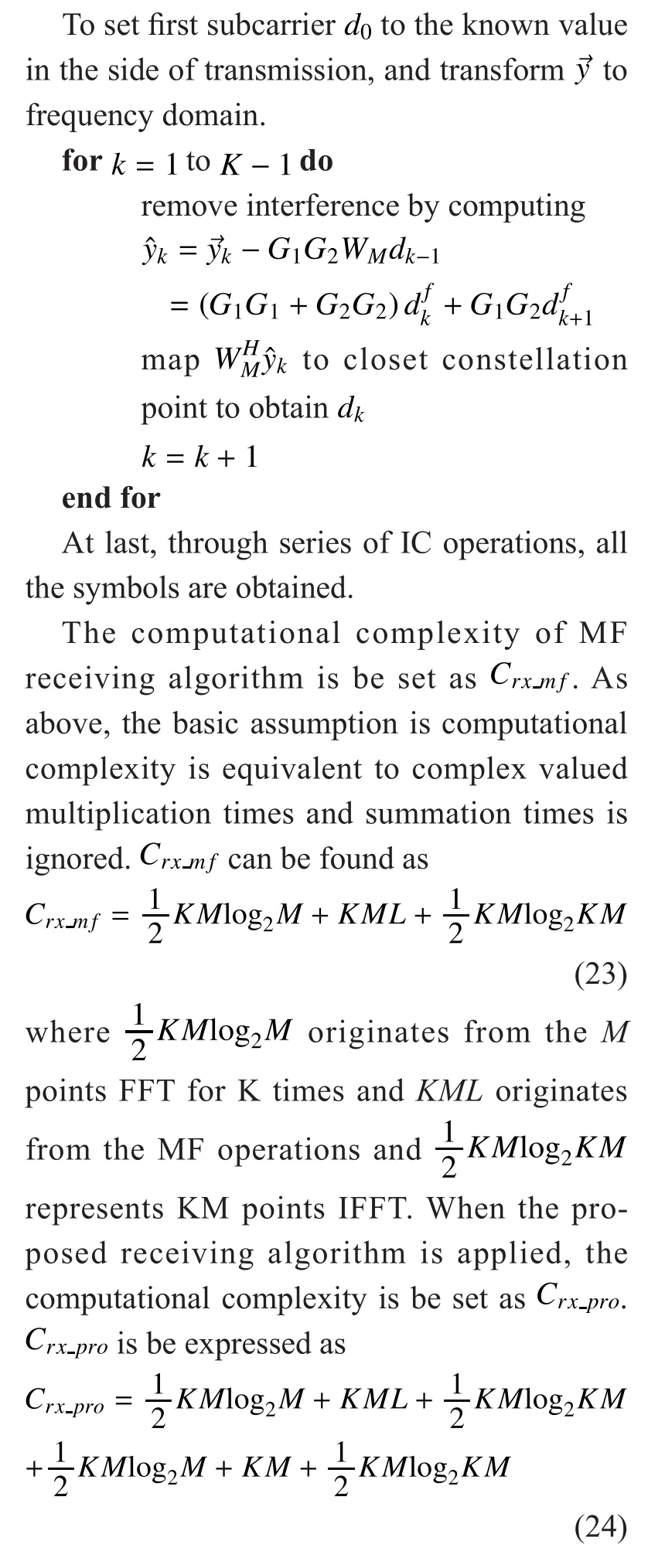
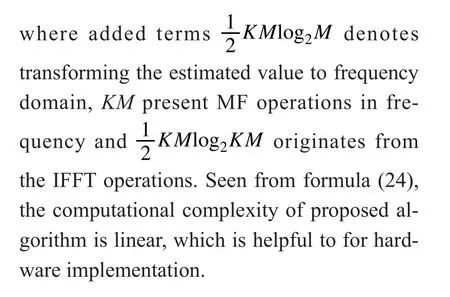
V. SIMULATION AND ANALYSIS
The power spectral density (PSD) of GFDM is simulated firstly to evaluate the out-of-band emission (OOB). The parameter of simulated is set as 128 subcarriers and 40 active subcarriers. For GFDM, the roll-off coefficientis 0.3 and number of subsymbols is 15. For OFDM, the number of symbol is 15 too. The modulation type is QPSK which is often used in satellite communications.
Fig. 6 shows the PSD contrast among the OFDM , GFDM with RC filter and GFDM with RRC filter. Compared with the power of main lobe, the side-lobe attenuation of OFDM,RRC-GFDM and RC-GFDM is about 13 dB,28 dB, 40 dB. The property of lower OOB makes GFDM more appropriate than OFDM in the satellite communication.
Fig. 7 shows the SER performance about MF, ZF and MMSE receiver in AWGN channel without channel coding. The parameter of simulation is 100 subcarriers and 9 subsymbols. There are no virtual subcarriers and no CP or CS. The roll-off factor of RRC filter is 0.5. When the RRC filter is adopted, it will improve the performance of MF receiver.The fold coefficient L in frequency is 2. The modulation type is QPSK. The range of receiving SNR is 0dB to 10dB. The simulation number of Monte Carlo is 50. As fig.7 shows,when the SNR is high, the performance of MF is worse because it cannot cancel the ICI of GFDM. In this case, ICI cancellation receiving algorithm is necessary. In the situation of low SNR, the performance of ZF is poor because it will increase the noise especially when the SNR is low. MMSE keeps good trade-off between increasing noise and self-interference suppressing, so the performance is best in all the situation at cost of highest complexity.Because of innate ICI, the performance of GFDM with MF/ZF/MMSE receiver is worse than theoretical performance of OFDM. However the out-of-band emission and PAPR of OFDM are so bad that it is difficult to apply conventional CP-OFDM in satellite communication. When GFDM is adopted in satellite communication, receiver property in low SNR is quite important. When the SNR is low, the performance of MF is very close to MMSE’s,because MF receiver makes the received SNR maximum. MF is a good choice to be applied in satellite communication.
Fig. 8 and Fig. 9 show the performance of proposed improved MF algorithm in AWGN channel and FSC channel respectively. The simulation parameter set is same as Fig. 7. The improved MF receiving algorithm is applied from designed pilot subcarrier. The known pilot subcarrier are inserted in frequency domain every 9 subcarrier. Seen from Fig. 8, in high SNR, the proposed algorithm has about 3~4 dB performance improvement than MF in the same SER. The performance of improved MF is even better than ZF within the area of 0~8.5 dB SNR. Fig. 9 shows the improved algorithm is also effective in frequency selective channel(FSC) which is set as satellite channel model C [22]. It has 1~2 dB improvement. The correctness of proposed algorithm is proved by simulation.
VI. CONCLUSION
Internet via satellite is a new paradigm which attracts lots of attention. In the future, satellite and terrestrial mobile communication system will be integrated to provide global coverage access to Internet. So, it is important to research the combination in air interface between 5G and satellite. In this paper, transmission scheme based on GFDM is introduced as the potential candidate waveform for space-terrestrial integrated system. The overview of GFDM is given and transceiver scheme is illustrated. What’s more, the com-plexity of modulation in time domain and in frequency domain is derived to propose a reference for choosing the better implemented method in satellite communications. At last,a new demodulation algorithm is proposed to improved MF’s SER performance in AWGN or FSC channel. The simulation results prove that this algorithm is effective.
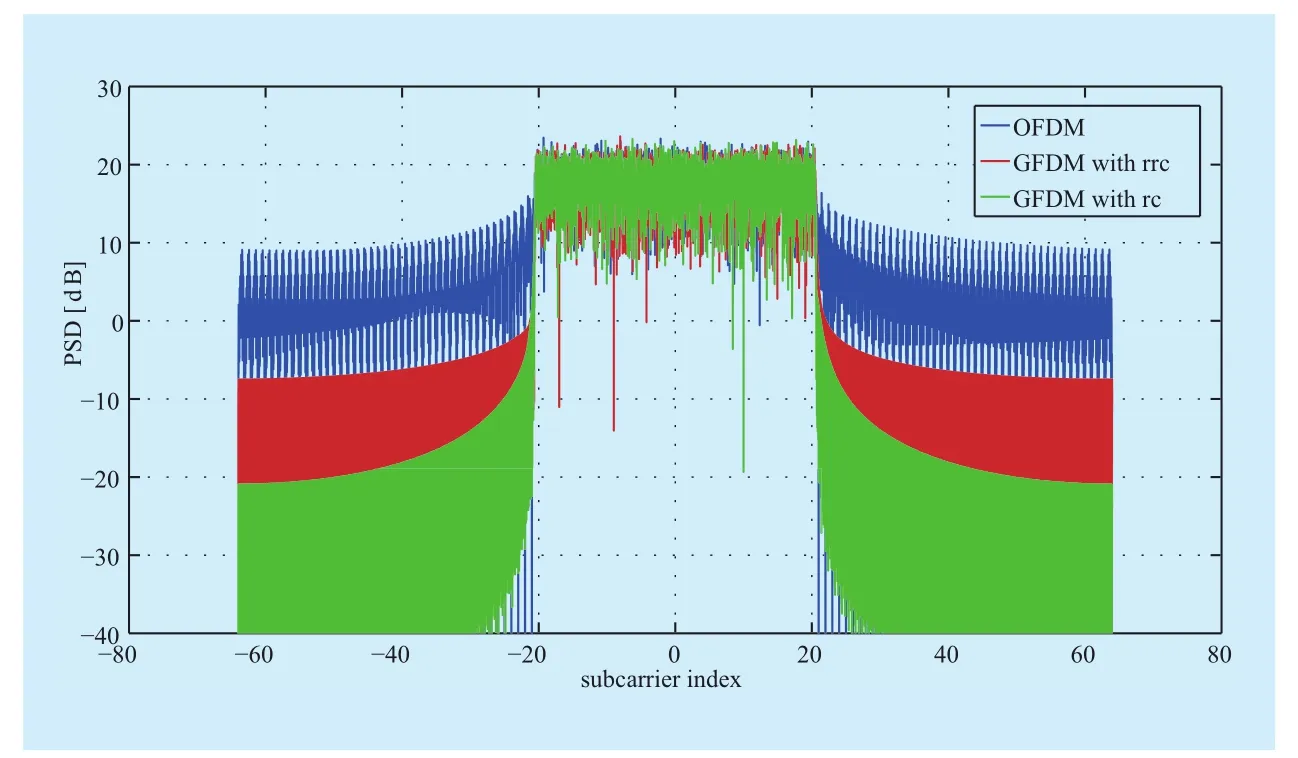
Fig. 6 PSD of GFDM and OFDM
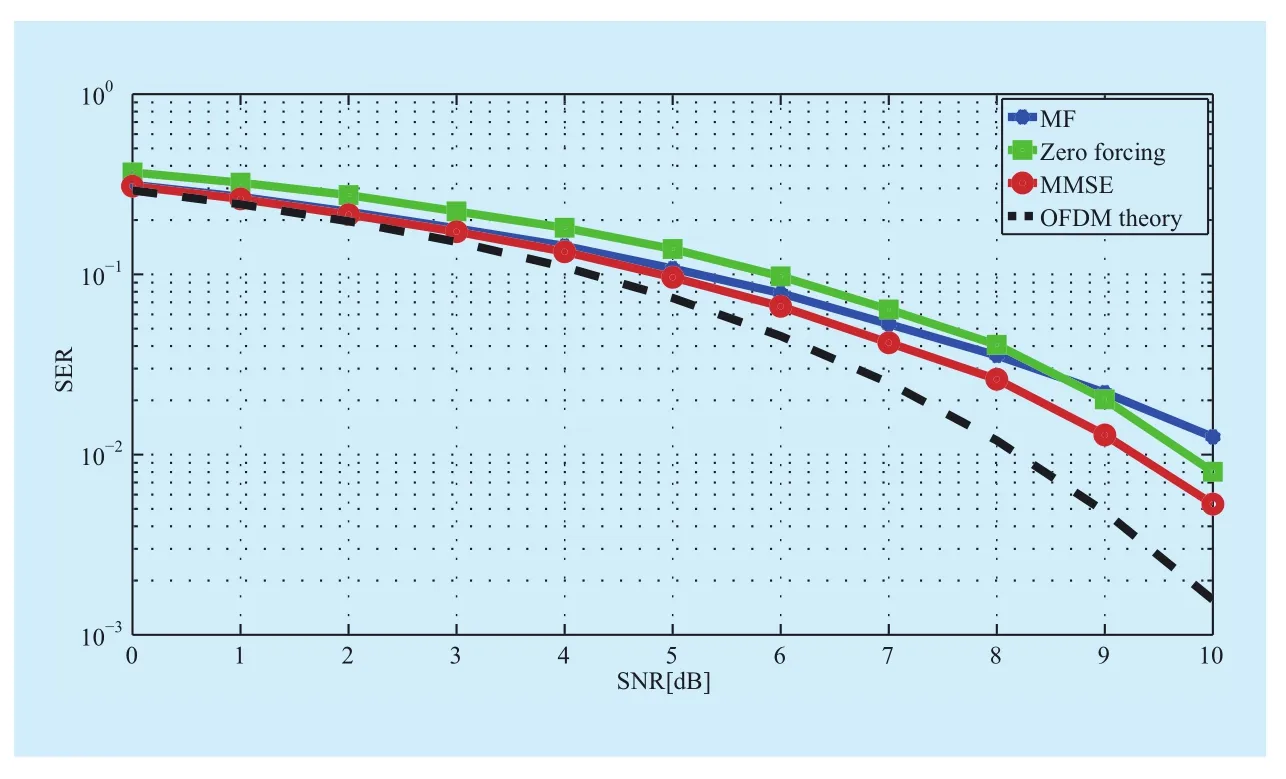
Fig. 7 SER of GFDM receiver with MF, ZF, MMSE in AWGN channel
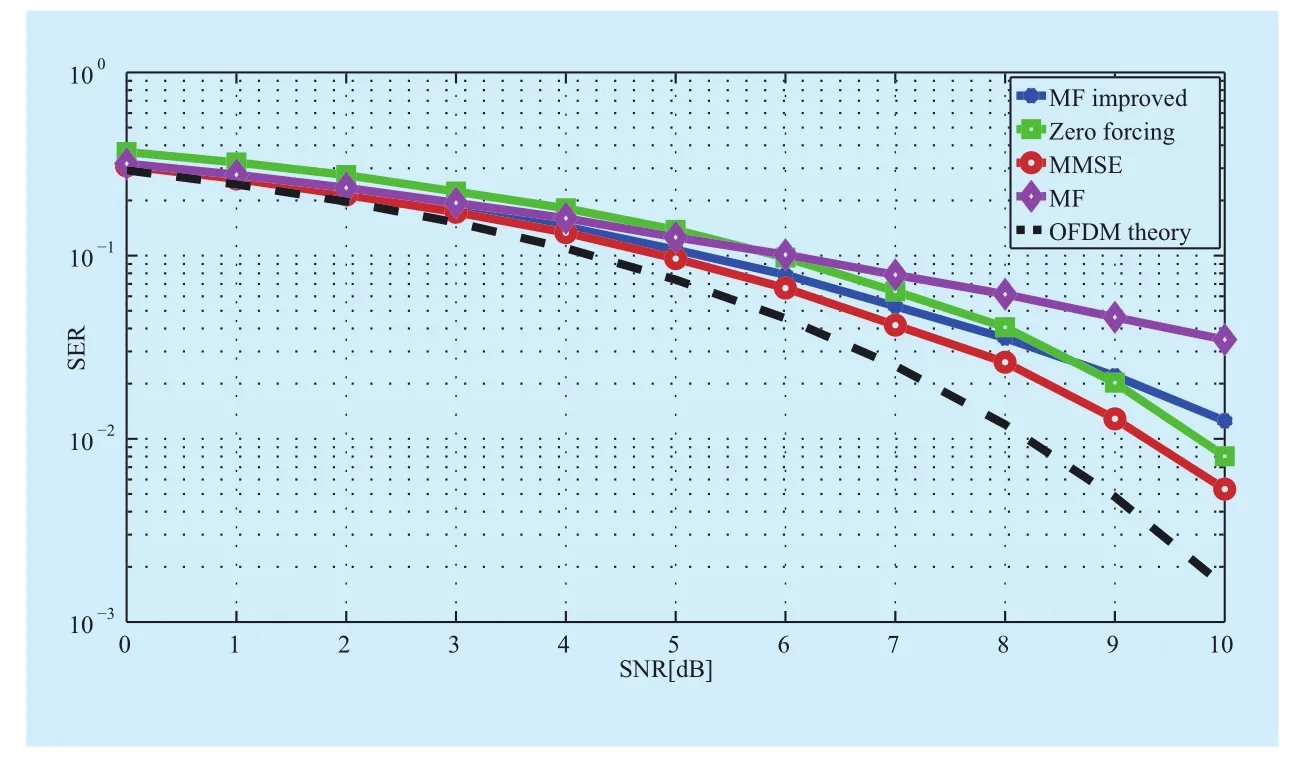
Fig. 8 SER of GFDM receiver with MF,ZF,MMSE and improved MF in AWGN channel
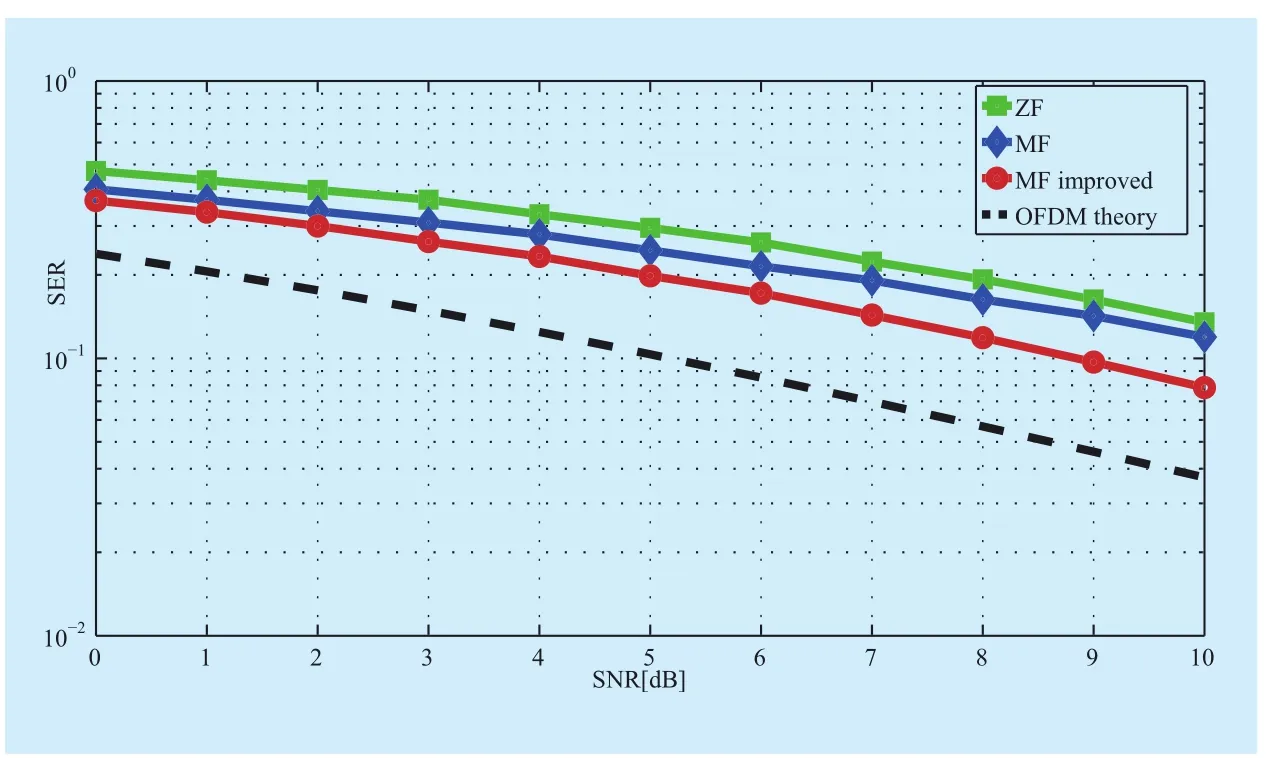
Fig. 9 SER of GFDM receiver with MF, improved MF and ZF in fsc satellite channel
ACKNOWLEDGEMENT
We gratefully acknowledge anonymous reviewers who read drafts and made many helpful suggestions.
[1] Desaraju, Venugopal, et al. “Internet over satellite – potential for digital inclusion”,International Astronautical Congress (IAC), September,2016.
[ 2] B. G. Evans, P. T. Thompson, G. E. Corazza, A.Vanelli-Coralli and E. A. Candreva, “1945–2010:65 Years of Satellite History From Early Visions to Latest Missions”,Proceedings of the IEEE, vol.99, no. 11, pp. 1840-1857, November, 2011..
[3] L. Siyang, Q. Fei, G. Zhen, Z. Yuan and H. Yizhou,“LTE-satellite: Chinese proposal for satellite component of IMT-Advanced system,”China Communications, vol. 10, no. 10, pp. 47-64, October, 2013.
[4] B. Evans, O. Onireti, T. Spathopoulos and M. A.Imran, “The role of satellites in 5G”,23rd European Signal Processing Conference (EUSIPCO),pp. 2756-2760, September, 2015.
[5] Dahlman, Erik, et al. “3G Radio Access Evolution--HSPA and LTE for Mobile Broadband”,IEICE transactions on communications, vol. 92, no.5, pp. 1432-1440, 2009.
[6] J.Dommel, G.Boccolini,et al., “5G in space:PHY-layer design for satellite communications using non-orthogonal multi-carrier transmission”,7th Advanced Satellite Multimedia Systems Conference and the 13th Signal Processing for Space Communications Workshop (ASMS/SPSC),pp. 190-196, September, 2014.
[7 ] Y. Tao, L. Liu, S. Liu, et al., “A Survey: Several Technologies of Non-Orthogonal Transmission for 5G”,Ch ina Communications,vol. 12, no. 10,pp 1-15, October, 2015.
[8] B. Farhang-Boroujeny, “OFDM Versus Filter Bank Multicarrier”,IEEE Signal Processing Magazine,vol. 28, no. 3, pp. 92-112, May 2011.
[9] Jiangang, et al. “Interference-Driven Designs of Nonlinear-Phase FIR Filter with Application in FBMC System”,China Communications,vol. 13,no. 12, pp 15-24, December, 2016.
[1 0] F. Schaich and T. Wild, “Waveform contenders for 5G — OFDM vs. FBMC vs. UFMC”,6th International Symposium on Communications,Control and Signal Processing (ISCCSP), pp. 457-460, April, 2014.
[11] N. Michailowet al., “Generalized Frequency Division Multiplexing for 5th Generation Cellular Networks”,IEEE Transactions on Communications, vol. 62, no. 9, pp. 3045-3061, September,2014.
[12] A. Farhang, N. Marchetti and L. E. Doyle,“Low-Complexity Modem Design for GFDM”,IEEE Transactions on Signal Processing, vol. 64,no. 6, pp. 1507-1518, March, 2016.
[13] Gaspar, Ivan, et al. “GFDM Transceiver using Precoded Data and Low-complexity Multiplication in Time Domain”,Mathematics, 2015.
[14] S. K. Bandari, V. V. Mani and A. Drosopoulos,“Multi-taper implementation of GFDM”,IEEE Wireless Communications and Networking Conference, pp. 1-5, April, 2016
[15] N. Michailow, S. Krone, M. Lentmaier and G.Fettweis, “Bit Error Rate Performance of Generalized Frequency Division Multiplexing”,IEEE Vehicular Technology Conference (VTC Fall), pp.1-5, September, 2012.
[16] Chen, Kwang Cheng, and S. Y. Lien, “Machine-to-machine communications: Technologies and challenges”,Ad Hoc Networks, vol.18,no. 3, pp. 3-23, 2014.
[17] I. Gaspar, N. Michailow, A. Navarro, E. Ohlmer, S.Krone and G. Fettweis, “Low Complexity GFDM Receiver Based on Sparse Frequency Domain Processing”,IEEE 77th Vehicular Technology Conference (VTC Spring), pp. 1-6, June, 2013.
[18] Xiang-Gen Xia, “A family of pulse-shaping filters with ISI-free matched and unmatched filter properties”,IEEE Transactions on Communications, vol. 45, no. 10, pp. 1157-1158, October,1997.
[19] R. Datta, N. Michailow, M. Lentmaier and G.Fettweis, “GFDM Interference Cancellation for Flexible Cognitive Radio PHY Design”,IEEE Vehicular Technology Conference (VTC Fall), pp.1-5,September, 2012.
[20] R. Datta, G. Fettweis, Z. Koll´r and P. Horv´th,“FBMC and GFDM Interference Cancellation Schemes for Flexible Digital Radio PHY Design”,14th Euromicro Conference on Digital System Design, pp. 335-339, September, 2011.
[21] D. Panaitopol, R. Datta and G. Fettweis, “Cyclostationary detection of cognitive radio systems using GFDM modulation”,IEEE Wireless Communications and Networking Conference(WCNC), pp. 930-934, April, 2012.
[22] Marques, By Antonio G. “Guidelines for Evaluation of Radio Transmission Technologies for IMT-2000, Recommendation ITU-R, M.1225”,Department of Electrical and Computer Engineering, University of Minnesota,2010.
- China Communications的其它文章
- Adaptive Application Offloading Decision and Transmission Scheduling for Mobile Cloud Computing
- Multi-Gradient Routing Protocol for Wireless Sensor Networks
- Smart Service System(SSS): A Novel Architecture Enabling Coordination of Heterogeneous Networking Technologies and Devices for Internet of Things
- Efficient XML Query and Update Processing Using A Novel Prime-Based Middle Fraction Labeling Scheme
- Degree-Based Probabilistic Caching in Content-Centric Networking
- Direction of Arrivals Estimation for Correlated Broadband Radio Signals by MVDR Algorithm Using Wavelet

